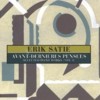Erik Satie, "Avant-Dernires Pensées: Selected Piano Works (Vol 1)"
 Writing brief and delicate music at a time when epic bombast was the norm, Satie's compositions would go on to become some of the most influential of the 20th century. This disc presents some of his best-known work as well as a few pieces that are less frequently heard but no less enthralling.
Writing brief and delicate music at a time when epic bombast was the norm, Satie's compositions would go on to become some of the most influential of the 20th century. This disc presents some of his best-known work as well as a few pieces that are less frequently heard but no less enthralling.
The three tracks that make up "Trois Gymnopédies" are among Satie's most instantly recognizable. These pieces strongly influenced both Debussy and Ravel, who would later rise to greater fame and recognition than Satie ever did in his lifetime. Here Bojan Gorisek plays with more patience than I've heard on others' recordings, and it's an interpretation that suits the works admirably. Also fairly well-known are Satie's "Gnossiennes." Gorisek's phrasing emphasizes the songs' rich harmonic peculiarities with abrupt bursts of volume. Whimsical and playfully erratic, these pieces embody both Satie's wit and eccentricities perfectly.
Although Satie was the music director of Montmartre's Chat Noir cabaret, not much of his music reflects this aspect of his life. One of the few telling influences of that experience comes through in his "Je te veux," a waltz that became a popular song on the nightclub circuit. It was meant to accompany bawdy lyrics by Henry Pacory, which unfortunately are not included here. The song itself is one of his more straightforward pieces yet not lacking for exuberance. "Embryons desséchés," translated as "Dried Embryos," Satie says is incomprehensible even to himself: "I wrote it despite myself, impelled by Destiny." Its moments of rapidity and harmonic texture make it one of Satie's more unusual works.
His one-act comedy, "Le Piège de Méduse," is a precursor of sorts to Dada and Surrealism, music Satie describes as "seven tiny dances for Jonah the monkey." First published alongside three Cubist woodcuts by Georges Braque, the work is also notable for the fact that Satie first performed it in 1914 with sheets of paper between the piano's strings and hammers, one of the earliest examples of prepared piano on record. The 21 tracks of his "Sports et divertissements" were written to accompany a set of etchings by Charles Martin. Averaging about 30 seconds in length, they concern upper class recreational activities such as hunting, yachting, golf, and tennis, and contain plenty of tongue-in-cheek ennui considering their brevity. Of these, the longest and most entertaining is "Le Tango perpétuel," or "Nonstop Tango," in which Satie repeats the same melodic phrases of this traditional form, prefiguring the use of loops and repetition that was to come several decades later.
Not only is this collection an excellent introduction to Satie's work and the fundamental ideas that many others would later draw upon, Gorisek's invigorating performances breathes new life into these compositions for those who are already familiar with them in the first place.
samples:



